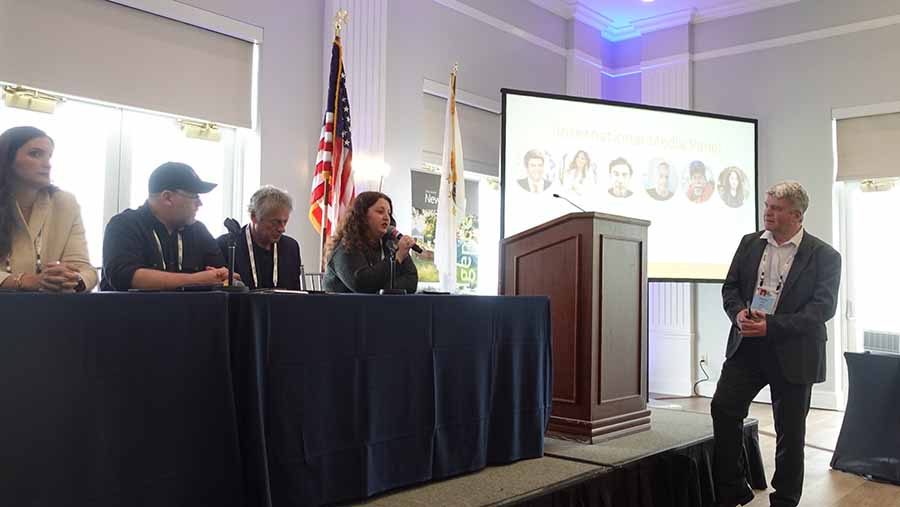
Discover New England tourism forum in Newport, Rhode Island, hosted an engaging forum with lead travel writers, moderated by Eoghan Corry, editor of Travel Extra.
Emily Jane Johnston
Emily Jane Johnston told the audience: What I do is content creation, but it’s a bit different from what everyone else does. What do people get wrong when marketing to content creators? What is the most common mistake they make?
I think it often comes down to the misconception that all content creators just sit around taking pictures of themselves all day. I’ve been doing travel writing both in London and the US, serving somewhat as an ambassador for my home country, promoting the beauty of places like New England. I currently live in South Carolina; I moved here on November 1st—interesting timing!
At 45 years old, I started my journey in content creation when I was 30. The majority of creators I encountered back then were between 17 and 19. Before this, I worked for a decade in PR and marketing and served as the director at an auction house. I had what many would consider a “real job” and a bit of life experience. I believed that social media was going to be the next wave of communication, enabling global sharing of products and information freely. For travel, it has been transformative, allowing me to connect with people on TikTok, Instagram, blogs, and YouTube. This platform has empowered me to tell stories and share destinations that might not be covered in traditional media.
We were also discussing that many traditional journalists now have social media profiles as well, which blends traditional media with content creation. There’s a misconception that content creation is just an extension of traditional journalism, but it is, in fact, quite different.
The most crucial mistake I see is that itineraries are often too packed. Content creators need time to engage with the places they visit and the stories they want to tell. Traditional journalists may experience a location, return home, and then write their pieces with the help of photographers. In contrast, we are constantly creating content in real time, which can be challenging if our schedules are overflowing. This often leaves little room to fully explore or convey the nuances of the locations we are in.
Steve Hartridge
Steve Hartridge editor of Selling Travel from Brighton in England advised the audience on the hosting of journalists and disseminating their message: I want to emphasize the importance of itineraries. They should serve as a starting point and be allowed to breathe a little. It’s essential to build in a couple of hours for journalists or travelers to explore the city or destination on their own. Last year, when I attended this show, most of the morning starts were scheduled for 7:30 AM, but there was one morning that began at 9:00 AM. I took that extra hour and a half to go for a jog around the village in Vermont. During my run, I spoke to a family who was driving up to see the eclipse. I learned a lot about what was happening in that village and received a few recommendations and tips from them. If I hadn’t had that time in the morning, I would have missed out on that rich aspect of the place.
The travel agent industry has gone through significant consolidation, and many agents have left the field. However, I believe that those who have left are often the good ones—those who understand that by becoming experts in a destination or product, they can make money. They can earn commissions and offer clients something valuable that they can’t easily find on the web. Our goal is to provide these agents with the information they need to make that difference.
When I attend a show like this, I often learn more in the first ten minutes after getting off the plane than I would through any Google search. My role on trips like this is to uncover those gems and nuggets of information that I can share with travel agents. This way, they can add real value when conveying information to their clients.
Stephane Abouard
Stephane Abouard from Paris told the audience that first hand stories ae an important part of a journalist’s work, drawing on his decades of experience as a war correspondent before he engaged in travel writing: “people talk about their experiences deeply. I have many examples of this. For instance, I was in Beirut six months ago during a bombing. I was living in the downtown area, and the people there welcomed me into their homes. After about 10 or 15 minutes, they shared their feelings with me—deep, heartfelt emotions. Unfortunately, this is a common theme in many areas.
For example, on October 8th, I was in Israel, in places like Tel Aviv and near Gaza. During that time, people also opened up about their emotions, expressing their feelings deeply. However, I noticed that, while they were being honest, they often tried to convey their emotions with a sense of sweetness—they weren’t going to share anything too harsh, instead holding onto their resilience and warmth. Each person I met during my work would share their life experiences within just 10 to 15 minutes, which is fascinating.
Today, in my new experience as a tourism journalist, I’ve noticed a significant difference. It’s essential to take the time to meet people and understand the region. The pace is not at all the same as in a war zone. In those situations, within just an hour, you might know everyone because they readily share their stories. But in more stable environments, it takes more time and patience to build connections and discover the rich stories that exist.
Claire Dodd
Claire Dodd from Manchester England told the audience: There are three main trends I’m currently seeing in the types of articles that editors are looking for. The first trend is the rise of listicles. These articles are great for SEO and tend to attract a lot of traffic to sites, so editors are increasingly focusing on them. This trend clearly indicates a strong online emphasis.
The second trend is a growing demand for articles that highlight undiscovered or less crowded alternatives to popular destinations. For example, readers are interested in exploring the lesser-known versions of iconic cities like Boston or New York. They are seeking out less crowded places and times to visit, such as shoulder seasons, and are looking for unique experiences to have during those periods. Many headlines in major newspapers currently reflect this, with titles suggesting readers discover lesser-touristic regions as great alternatives to the well-trodden hotspots.
The third significant trend is a focus on personal experiences. More and more editors want writers to place themselves at the center of their stories. This trend shifts the narrative to showcase destinations through a personal lens. Although it’s not something I’m traditionally accustomed to, I recognize its growing importance. Editors are looking for someone with a unique perspective who can convey the essence of a region, town, or destination. For instance, stories about exploring ancestral roots—such as rediscovering a place where one’s mother grew up—are increasingly popular. The possibilities for these types of narratives are vast, but they all revolve around creating a personal connection that roots a sense of place in the reader.
One of my biggest tips for building an itinerary for media is to prioritize “show, don’t tell.” We need to engage deeply with the experiences rather than simply observe them. Going through a packed schedule of appointments and just seeing a museum does not compare to actively participating in an experience. I tend to write with greater color and vividness when I have an emotional connection to what I have actually done.
For example, if there’s a maritime museum, we want to visit, but we also need to delve deeper into the backstory of the locale and the people associated with it. It’s essential for us to meet the shipbuilders or even sail a ship to truly connect with the experience.
Wolfgang Greiner
Wolfgang Greiner updated the audience on the German market: I believe there is no such thing as a single German market, or a French market for that matter. Every traveler is different, with varying interests. When you invite journalists to your business or event, it’s crucial to find out who they are writing for and what their main interests are. This understanding allows us to determine whether it’s a good fit and discuss how we can collaborate on content creation and how we’ll fill our days with meaningful activities when it’s time to write or create content.
In this sense, I wouldn’t say there are significant mistakes being made; rather, sometimes we simply don’t know who we’re talking to. It’s essential to have those discussions. Conferences and trade shows, such as the big ITB in Berlin, serve as great meeting places because they allow you to come to Germany and learn about our culture. This cultural understanding is vital for knowing who might visit your country later on and enjoy what you offer.
I will also agree with Emily that we need a bit of time. As a traditional journalist with a side gig as an Instagrammer, I recognize that I’m a bit of an outlier at 56 years old. I’m not trying to compete with younger influencers, but I do believe in the value of genuine storytelling and the importance of building relationships.
Stephane Abouard on Cheese
Stephane Abouard from Paris told the audience: The first two days were a bit special for me—I arrived in this country feeling sick, but despite that, I’ve really enjoyed my time here. Boston has been wonderful. We had the chance to visit some fantastic museums, especially the [Margaret] one. I also got to try new foods—for example, yesterday afternoon, we went to the Boston Public Library and had a proper tea time. That was my very first experience like that, and I loved it!
Of course, I wish the weather had been a little better. To be honest, I left Paris with 24°C and sunshine (which is rare for April!), so I was a bit disappointed to find it colder here. But this region is truly beautiful—the town we visited yesterday, the landscapes I saw today—everything is stunning. I’m very curious to explore more of your region and, of course, to taste more of the food, especially seafood.
I also heard you have hundreds of cheeses here—wow! I’m a little jealous because, as you may know, France has exactly 572 cheeses. I’d love to try some of yours—maybe 10 to start?
Moderator Eoghan Corry intervened to say You’ve been warned—lock up your cheese!
Emily Jane Johnston on SEO
Emily Jane Johnston had some surprising advice for the audience of tourism officials on optimising search engine optimisation for their websites: I think everyone can relate to this. I have had a couple of videos that are good examples of what I’m talking about. For instance, I was in Boston in December and created a few daily diary videos showcasing incredible places around the city. One of those places was the Beacon Hill bookstore. When I went in, I faced a decision: I could either include it in a diary video or create a standalone video just for it. I ultimately decided that this bookstore deserved its own space. I didn’t think about SEO or anything like that; I just knew this was the best bookstore in Boston—one of the coolest places that you’ve probably never been.
I have this personal pet peeve: I really dislike showcasing a full experience or place. I believe the joy lies in only revealing a little bit, which encourages people to go see it for themselves. So, I intentionally left out a few details and posted the video with the caption, “This is a cool bookstore.” I mentioned to the Boston tour that I was going to upload it, clarifying that it wasn’t heavily related to them—it was simply a cool bookstore.
To my surprise, the video reached over four million people across multiple platforms. Everyone started asking, “What was your SEO trick?” and I had to tell them, “There wasn’t one.” I walked into a cool bookstore, made a simple video about it, and that was it. People were really curious about what keywords I used, searching for a recipe for success.
The truth is, there isn’t a one-size-fits-all method. It’s about throwing a bunch of stuff at a wall and hoping something sticks. However, you have to actually be the person who throws it at the wall for anything to stick. So many people are not getting that message—that’s why I’m happy to deliver it. What everyone wants to hear is often the wrong thing.
Wolfgang Greiner on SEO:
Wolfgang Greiner told the audience: SEO is horror! It’s a ton of work—seriously, just as much as writing the story itself. Sometimes you can’t even focus on the writing because you have to obsess over keywords, repetition, subheadings, and headlines. Oh my god, it’s a whole science!
I’m an old-school journalist who used to just put words on paper and hope someone would pick it up at the kiosk. Now? You have to beg Google to notice you. But fine—if you want to be found, you have to play the game.
I’m super jealous of people who go viral with their art or whatever you call it. Everyone deserves their moment of fame, but SEO? That’s a tough one. Google keeps changing the rules—what you learned a year ago (maybe even paid for in a course) might be useless today.
Still, it’s worth it. Most of you probably know what SEO is, but the key is being hyper-specific with your content. If you nail it, Google might actually feed your name, property, or business into other people’s searches.
Emily Jane Johnston on itineraries
Emily Jane Johnston told the audience: my new directive for the past nine months has been to connect these travelers with you. In my videos, I’m introducing them to your product, your hotel, your store, and your tourist board. My main goal is to encourage them to follow you and seek out your information. I’m providing just a taste, trying to get them in your front door, without giving away all the details. I think this is true for all of us—we’re simply starting the story, and then they continue that story with you. That should be our ultimate goal.
Trust your gut when it comes to identifying something special. A lot of the time, it’s about enlisting the right storyteller to help publicise that. This means choosing the right publication, choosing the right influencer, and ultimately selecting the right partner to work with to convey your story effectively.
I also want to reiterate the importance of being a partner with your content creator or writer by discussing the itinerary with them. Steve, you made a great point when you mentioned that sometimes people just send an itinerary and feel like their job is done. I’ve found that I am often rewarded by tour operators who not only send an itinerary but follow up with another email asking for my thoughts. I may respond by saying, “I’ve done enough sailing features or road trips this year”—something that shows I know my audience. I can tell them, “I appreciate you sending this, but is there anything else we can do that might resonate more with the people I’m communicating with?”
Ultimately, it’s about listening to the person you’re working with and taking their advice regarding their audience. As content creators, we often receive about 3,000 direct messages a day. I try to read and respond to as many as I can because many of us are in direct contact with our audience. It’s all about maintaining that feedback loop. I think it’s an outdated mentality to send an itinerary and then assume, “My job is done.”
Links: Discover New England tourism forum – DNE media panel discussion –
Boston city – Afternoon tea in Boston library – Boston Museum of Fine Art – China Pearl, in Boston’s Chinatown – Isabella Stewart Gardner Museum – View Boston panoramic tower
Hartford, Connecticut – Madison, Connecticut – Mashantucket Pequot Museum – Mystic Seaport Museum – Mystic, Connecticut – New Bedford, Massachusetts – New Haven Connecticut – Newport, Rhode Island – South Eastern Massachusetts – Westerly, Rhode Island



